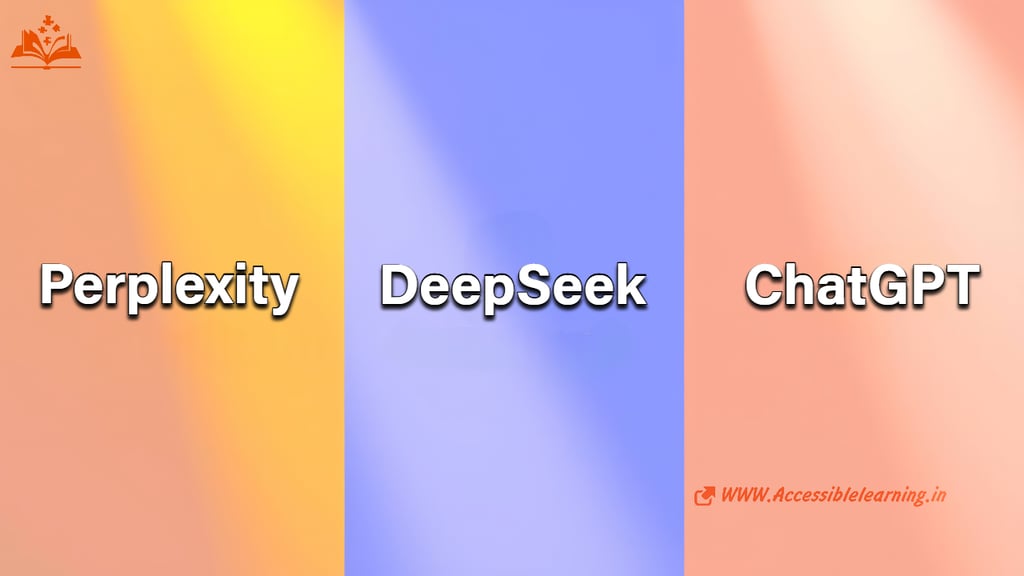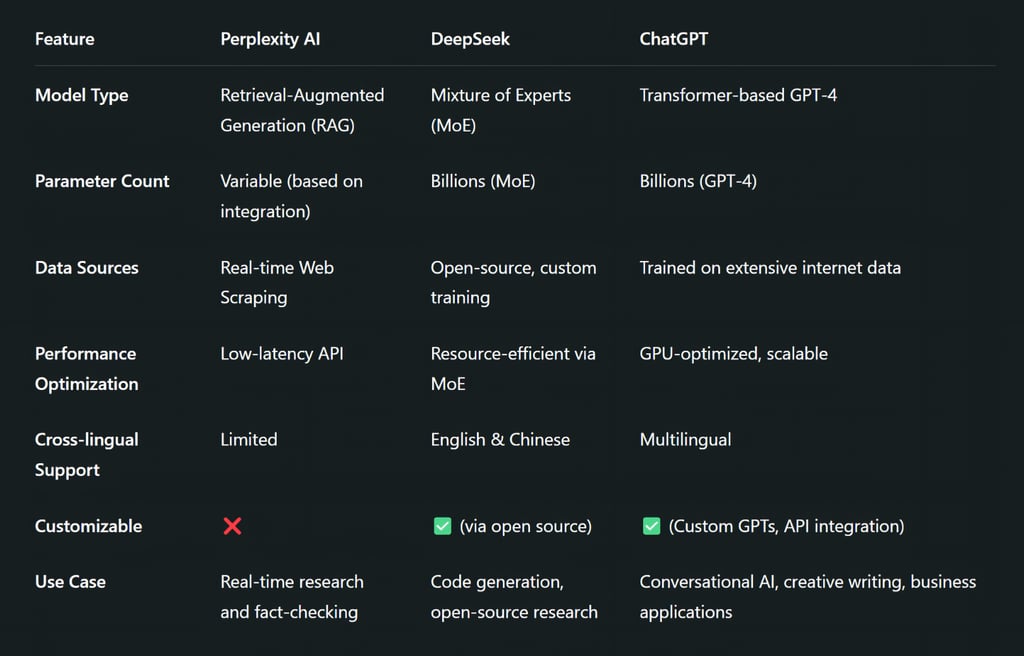
DeepSeek, Perplexity, or ChatGPT: A Technical Comparison of AI Models in 2025
A comprehensive comparison between Perplexity AI, DeepSeek, and ChatGPT. This article dives into the technical aspects, key features, and ideal use cases of each AI model, helping developers, researchers, and business users choose the best tool for their needs in 2025.
AI ASSISTANTAI/FUTURECOMPANY/INDUSTRYEDUCATION/KNOWLEDGE
Sachin K Chaurasiya
4/19/20257 min read


In the fast-paced world of generative AI, three major players have carved out strong reputations for their intelligence, usability, and innovation: Perplexity AI, DeepSeek, and ChatGPT. Each of these tools brings a unique approach to AI-powered conversations, content generation, and real-time assistance. But how do they really compare in 2025? Let’s unpack their strengths, differences, and ideal use cases in this human-friendly, SEO-optimized breakdown.
What is Perplexity AI?
Perplexity AI is a conversational search engine powered by advanced LLMs (Large Language Models). Think of it as Google meets ChatGPT — it doesn't just fetch links; it gives you direct, cited answers based on real-time web data. It focuses heavily on transparency, offering citation-based responses that show exactly where the information comes from.
Key Features
Real-time Web Access: Pulls answers from the internet instantly.
Sources & Citations: Offers clickable sources for every claim.
Pro Model: Gives access to Claude, GPT-4, Mistral, and more.
Follow-up Mode: Enables dynamic multi-turn conversations.
Architecture & Model
Perplexity AI leverages a combination of transformer-based language models from different AI research groups. It integrates models like Claude, Mistral, and GPT-4, offering multi-modal support (text, image, code). The underlying architecture is built to retrieve relevant information in real time from the internet. It employs a sophisticated retrieval-augmented generation (RAG) model to ensure that it pulls in up-to-date and relevant web data into responses.
Real-Time Web Access
Web Scraping & Knowledge Graphs: It incorporates live web scraping technologies to ensure up-to-the-minute data, connecting with knowledge graphs to structure and refine the information it retrieves.
Search-First Approach: Instead of just generating text, Perplexity uses an advanced query generation model to match the user’s request with relevant web results and citation links. This results in responses that are not only relevant but also backed by sources.
Performance and Speed
The API-based architecture of Perplexity AI ensures low-latency responses, especially for fact-checking and research queries.
Optimized for multi-turn conversations, ensuring that follow-up queries stay contextually relevant to prior exchanges.
Strengths
Real-Time Web Access: Pulls current, up-to-date data directly from the internet.
Source-Cited Responses: Provides links and citations, great for research and fact-checking.
Multi-Model Integration: Uses various models (Claude, GPT-4, Mistral) depending on the task.
Simple, Search-Like UI: It feels like using Google and ChatGPT, ideal for fast information retrieval.
Weaknesses
Limited Customization: You can't train or fine-tune it like ChatGPT or DeepSeek.
Not Always Creative: More focused on factual data than creative writing or ideation.
Dependence on the Web: Performance can be inconsistent if live web access is interrupted.
Best For
Research-heavy tasks
Students, analysts, and journalists
Users who want fact-checked responses


What is DeepSeek?
DeepSeek is a rising AI model developed in China, designed to be an open-source alternative to GPT-style models. It focuses on bilingual fluency (especially English and Chinese) and is especially powerful for code generation, reasoning tasks, and document understanding. Its architecture is based on a Mixture of Experts (MoE) model, making it lightweight and scalable.
Key Features
Open-source and community-driven
MoE Architecture: Efficient and cost-effective
Great for Technical Users: Particularly useful for coders and researchers
Supports Chinese & English fluently
Architecture
Mixture of Experts (MoE): DeepSeek utilizes MoE architecture, where only a subset of models (or "experts") are activated per task, making it more efficient than fully dense models like GPT. This allows it to scale while remaining resource-efficient.
Parameter Count: DeepSeek employs models with billions of parameters, enabling it to process highly complex language tasks and large-scale reasoning. The model is customizable and can be extended by the community.
Technical Features
Cross-Lingual Support: DeepSeek’s design focuses heavily on bilingual language support, particularly English and Chinese. The underlying bilingual embeddings are tailored to support cross-lingual tasks.
Custom Training: Since DeepSeek is open-source, it allows developers to train the model on their own datasets. This flexibility makes it highly appealing to research institutions and companies looking for tailored solutions.
Code Generation
DeepSeek’s MoE model is well-suited for generating structured content, including code snippets in multiple programming languages. The MoE system makes it efficient in handling complex, highly specific tasks like code optimization and debugging.
Resource Efficiency
The MoE architecture allows DeepSeek to scale by using fewer computational resources compared to full transformer-based models, providing an advantage for running in low-resource environments.
Strengths
Open-source: Fully customizable; developers can modify the model and retrain it.
Efficient MoE Architecture: Mixture of Experts makes it scalable and resource-friendly.
Multilingual Focus: Strong bilingual support, especially for English and Chinese.
Strong Coding Capabilities: Performs well in structured content generation, like code.
Weaknesses
Developer-Focused: Not beginner-friendly; requires technical expertise to deploy or fine-tune.
Limited Ecosystem: Fewer third-party tools or integrations compared to ChatGPT.
Smaller Community Support: Still growing, so documentation and support are more limited.
Best For
Developers and data scientists
AI researchers exploring model performance
Technical applications requiring customizable models


What is ChatGPT?
ChatGPT (by OpenAI) is the most widely used AI chatbot today, known for its versatility, reliability, and personalization features. With the release of ChatGPT-4 Turbo, users get faster, smarter, and more affordable AI assistance — whether you're writing blogs, coding, studying, or just chatting.
Key Features
Custom GPTs: Build your own personalized AI assistant
Image, Code, and File Support
Plugins & Tools Integration: Browsing, DALL·E, Python, etc.
Cross-platform Access: Mobile, desktop, and browser apps
Architecture
GPT-4 Model: ChatGPT is based on OpenAI’s GPT-4 architecture, a transformer model that has been trained on trillions of tokens from a variety of internet sources. GPT-4 is known for its larger context window and ability to understand nuanced language, making it suitable for complex conversational tasks.
Custom GPTs
One of the key technical differentiators for ChatGPT is its ability to create custom GPTs. Developers and businesses can upload their datasets and APIs and even integrate external tools to create domain-specific AIs. This feature allows ChatGPT to be customized for a wide variety of applications, from customer service to advanced research assistants.
Performance and Scaling
GPU-Optimized: OpenAI’s implementation of GPT-4 relies on massive GPU clusters, leveraging distributed computing to handle billions of queries simultaneously. The system is designed to scale, ensuring consistent and quick responses regardless of the load.
Fine-Tuning Capabilities: ChatGPT offers fine-tuning options for specific use cases, allowing developers to adapt the model further with minimal resource overhead.
Multi-Modal Abilities
Image Generation (via DALL·E integration): ChatGPT can generate images and text-to-image outputs with its integration with DALL·E.
Code Interpreter & Python: Users can use Python code execution directly within the interface, allowing for real-time calculations and data analysis.
File Support: ChatGPT can upload and process files (like PDFs and CSVs), allowing it to handle large datasets and provide insights or even summarizations from the documents.
API Integration
ChatGPT offers robust API access for developers, allowing for seamless integration into third-party applications, bots, and platforms. This makes it easy to build interactive, real-time chatbots or customer service tools using GPT-4's capabilities.
Strengths
Highly Versatile: Great at creative writing, business use, coding, teaching, and chatting.
Custom GPTs: Allows you to build specialized models using your own data and APIs.
Multi-Modal: Can process text, images, and documents and run Python code.
Massive Ecosystem: Backed by OpenAI with continuous updates, support, and API access.
Weaknesses
No Real-Time Web Access (without plugins): Outdated info if not connected to the web.
Subscription Paywall: GPT-4 and advanced tools are behind a monthly fee.
Generic by Default: Without custom GPTs or fine-tuning, responses may lack niche specificity.
Best For
Content creators and marketers
Business owners and students
Anyone looking for an all-in-one AI assistant


Which AI is Right for You?
Choosing between Perplexity, DeepSeek, and ChatGPT depends on your goals:
If you need real-time data and trusted sources, go with Perplexity AI. It's like having a scholar and a search engine rolled into one.
If you’re a developer or researcher looking for open models, DeepSeek is a fantastic choice. It gives you control and efficiency.
If you want a creative, conversational, and versatile AI, ChatGPT is your go-to tool for writing, brainstorming, learning, and beyond.
FAQs
Which AI model is best for real-time information and web search?
Perplexity AI is the top choice for real-time information retrieval. It integrates live web data and provides cited sources, making it perfect for research and fact-checking.
Can I customize or fine-tune DeepSeek AI?
Yes, DeepSeek is open-source and built with a Mixture of Experts (MoE) architecture. This allows developers to fine-tune the model using custom datasets and adapt it for domain-specific use cases.
Does ChatGPT support image and file input?
Absolutely! ChatGPT (especially GPT-4 Turbo) supports multi-modal inputs, including images, documents (like PDFs), and even Python code execution for advanced use cases.
Which model is most suitable for coding assistance?
All three have coding capabilities, but ChatGPT and DeepSeek stand out. ChatGPT is great for general coding help and debugging, while DeepSeek excels in structured code generation and multilingual code support.
Is Perplexity AI free to use?
Yes, Perplexity AI offers a free tier with web search capabilities. However, for advanced features and access to larger models like GPT-4 or Claude, you may need a paid subscription.
Which AI model is more beginner-friendly?
ChatGPT is the most user-friendly, especially with its clean interface, guided tools, and the ability to create custom GPTs without coding. Perplexity is also simple, but DeepSeek is more suited to developers and researchers.
Perplexity AI stands out for real-time information retrieval, perfect for users seeking accurate, sourced data quickly.
DeepSeek excels in customization and scalability and is particularly ideal for developers and researchers working on technical or multilingual applications.
ChatGPT is the most versatile, offering a robust API, multi-modal integration, and powerful tools for various creative and business tasks.
By understanding the unique technical capabilities of each platform, you can choose the AI model that best aligns with your needs and technical expertise.
Subscribe To Our Newsletter
All © Copyright reserved by Accessible-Learning Hub
| Terms & Conditions
Knowledge is power. Learn with Us. 📚


